Introduction
A walking safari is different to your routine lodge experience where you will be driven everywhere and not allowed off the vehicle except for tea/coffee or sundowners.
Instead you will be out in the wilderness areas, on foot, away from the hustle and bustle of the lodge where time will be measured by the length of the shadows and position of the sun.
It is a unique way to experience the African bush, allowing you to easily touch, feel and smell nature, immersing yourself in the sights and sounds around you without the usual growl of a diesel engine drowning out the nuances of the African bush.
Walking safari contents
- What is a walking safari?
- Are walking safaris safe?
- How to survive a walking safari?
- What are the rules of a walking safari?
- How many days do you need for a walking safari?
- What is a wilderness backpacking trail?
- What is the best month to go on a walking safari?
- What colour should you not where on safari?
- What kind of shoes should I wear on a walking safari?
- What to do when putting on your shoes on a walking safari?
- What should you pack for a walking safari?
- What should you wear on a walking safari?
- What do you wear to a safari dinner?
- Can you go on a walking safari in Kruger National Park?
- How old do you have to be to go on a walking safari?

Rhodes Bezuidenhout of Shangani Trails leads a walking trail through the fever tree forest of Makuleke. Photo: © Rhodes Bezuidenhout
1. What is a walking safari?
A walking safari is an activity where guests are taken into the reserve to view wildlife on foot rather than in a game vehicle. The guided walk is led by an experienced guide who can describe and interpret the many species of wildlife that they encounter along the way.
2. Are walking safaris safe?
If you are walking in a Big 5 Game Reserve, there is always a chance of encountering dangerous animals. Your safety is of paramount concern with your guide always leaning towards the conservative, minimizing risk to ensure you have a highly enjoyable but safe experience.
Invariably your guides will be armed with high calibre rifles, which are seldom used except as a last resort.
3. How to survive a walking safari?
Walking in the bush is largely common sense. You will be led by a trained guide who is knowledgeable of animal behaviour and of the African bush. Listen to your guide, he or she will never give you an unreasonable command and will always have your safety in mind.
For real life examples of what to do and not do give the following article a quick read: Whatever you do, don’t run.
4. What are the rules of a walking safari?
- Stay in single file within an arm’s reach
- Stay behind the rifle at all times
- Listen to and obey the commands of the guide
- Do not run. WHATVEVER you do, do not run
- No talking while walking
5. How many days do you need for a walking safari?
Your length of stay can vary depending on how much you want to see and do. But usually a walking safari will last for three nights/ four days with some stretching to five nights/ six days, particularly if you are on a wilderness backpacking safari.
6. What is a wilderness backpacking safari?
A wilderness backpacking safari is a 3-5 night walking trail where you carry all your essential but limited necessities in your backpack. Walking through Big 5 country you will be totally immersed into the bush. Watches are surrendered with time being measured by the position of the sun.
For those who want a real close to nature bush experience then sleeping under the African star laden night sky is the answer.
A backpacking safari such as this requires the guests to dig for water in dry riverbeds or collect it from natural springs. Participants learn how to set up an eco-friendly campsite, keep watch over a small fire while others sleep and depart for the next leg of the trail the following morning leaving little or no trace of their presence.
Wilderness backpacking safaris are led by experienced Trails Guides and feed off their passion for the African bush. The only requirements being a spirit of adventure, a love of nature and the ability to spend long periods carrying a backpack!
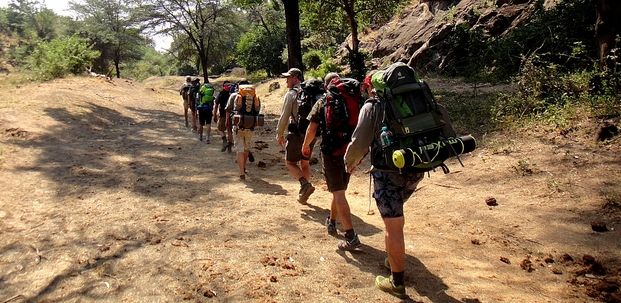
A party on a wilderness backpacking trail file through the African bush laden with their essentials for there 3 to 5 nights in the wild. © Rhodes Bezuidenhout
7. What is the best month to go on a walking safari?
Winter in Africa, April to October, is a good time to walk in the bush. Temperatures are milder during the day, there is little or no rainfall and the bush itself is not as dense as it would be in summer allowing you to see more.
In addition, small water resources would have dried up forcing the animals to converge on established water points making for better viewing.
8. What colour should you not wear on a walking safari?
Try to avoid uniform colours like all white or black, also bright colours such as red, yellow or pink. And do not wear camouflage clothing as this could be met with suspicion by the authorities. Rather wear colours such as brown, khaki or green to help you lend in.
9. What kind of shoes should I wear on a walking safari?
When walking in the bush, a good, comfortable pair of hiking boots are best. You will likely encounter a terrain consisting of many different varieties of large thorns and spikes which open or light shoes will find difficult to contend with.
Closed shoes at night are essential to avoid the sting of any scorpions or bites from insects that may be active on the ground.
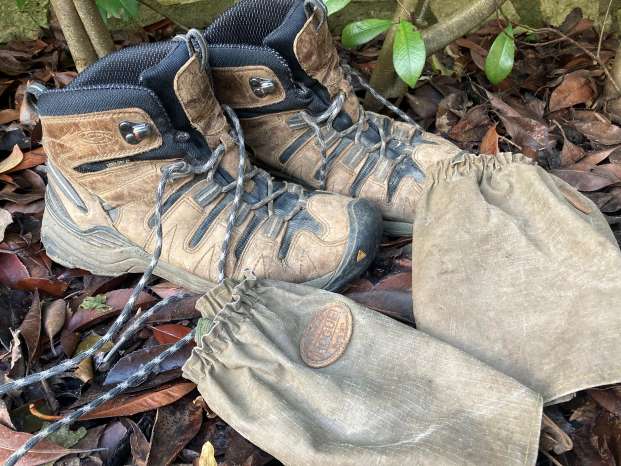
A sturdy pair of walking boots together with a pair of gaiters to keep seeds from getting into the boots and socks.
10. What to do when putting on your shoes on a walking safari?
Before you put on your shoes always give them a good shake, a tap and look to ensure that nothing has crawled in. The last thing you want to do is put your foot in to find a scorpion at the other end. Remember – Shake, tap and look.
11. What should you pack for a walking safari?
Standard recommended equipment would be a good hat, camera, binoculars, a good torch and spare batteries, high factor sunscreen, insect repellent, water bottle, a light raincoat (just in case) and a light day pack in which to carry your personal effects on the walks.
Please don’t forget any personal medication that you may require on a daily basis. If you are participating in a wilderness backpacking safari, the essential item list would be a great deal longer with details being provided by your hosts prior to the trip. Walking trails in Africa could well involve visiting malaria areas, make a point of asking your host about this and consulting your private doctor for advice accordingly.
The full list of what to pack:
- Cameras
- Binoculars
- Bring spare batteries for your cameras as there may be no electricity in the camp
- Neutral coloured clothing, greens, browns, khaki etc. Please note that there maybe no laundry service in remote areas
- Evenings and mornings may be chilly so bring fleeces, jersey, bush jacket, beanie etc
- A light raincoat just in case
- Casual clothes for around camp
- Open shoes during the day in the camp, closed casual shoes for night time around the fire
- Wide brimmed hat
- Good walking shoes
- A small light day back-pack to carry personal effects on walks
- Water bottles, at least a litre to be carried by each person. Two litres will be even better
- Personal toiletries, personal medication – malaria medication may be required depending upon the areas
- Sunblock- high factors
- Personal snacks you may want on the walks, fruit and other snacks may be available at the camp
- A good torch or headlamp, plus spare batteries- Very Important
So this is what you should pack, but what is in the back pack of your trails guide? To find out give the following post a skim: What’s in the bag?
12. What should you wear on safari?
It’s all about the layers. The temperature is going to vary greatly, especially in the winter. A fleece, gloves and hat for the mornings and a pair of combat trousers that convert to shorts may be required. Colours should be neutral, khaki, browns and greens.
A light weight long sleeved shirt will keep the sun off your arms and neck during the day and stop the mosquitos biting in the evening.
In the African winter, you can expect frosty mornings and evenings with daytime temperatures being largely mild and warm, whereas summer will entail warm mornings, hot days and balmy nights.
December through to March is largely known as the rainy season, so raincoats would be advisable. Durable, sensible but light clothing that you can accept being torn by the odd thorn or two should be worn.
A light fleece or jacket for the chilly mornings or evenings is essential. Wearing shorts or long pants is a personal preference as long as you are comfortable, there are a number of lines of bush clothing available where they have long pants that can be converted into shorts through a series of well placed zips in the legs.
13. What should you wear for a safari dinner?
Dinners at a lodge or tented camps are largely informal affairs and casual everyday clothing of any colour is usually the norm. Good, sensible closed shoes are essential for night-time wear to protect you from a biting insects and snakes. Taking a torch to dinner should be classed as essential wear.
14. Can you go on a walking safari in Kruger National Park?
The South African National Parks Board (SANPARKS) operate Kruger National Park and offer walking safaris out of tented camps, backpacking wilderness trails and morning walks out of the various rest camps in the Park.
Private Concessions such as The Makuleke Concession also offer Walking Safaris through operations such as Shangani Trails.
15. How old do you have to be to go on a walking safari?
A minimum age of 16 is recommended for walking safaris by FGASA (Field Guides Association of Southern Africa). However, if parents take full responsibility for the actions of their children ensuring they follow all the rules and instructions of the guide then children 12 and over may attend.
Discover more
This article was written by Rhodes Bezuidenhout of Shangani Trails. To find out what a tailor made walking safari could be like drop Rhodes a line. His email contact details can be found on his blog profile.
You can also find out how to stay safe on a walking safari, along with some first hand experiences from the author, James Bailey, by checking out this Fascinating Africa article: Whatever you do, don’t run.
Find out everything there is to know about the role of a safari guide and what it takes to become one by checking out our definitive guide on the Safari Guide.

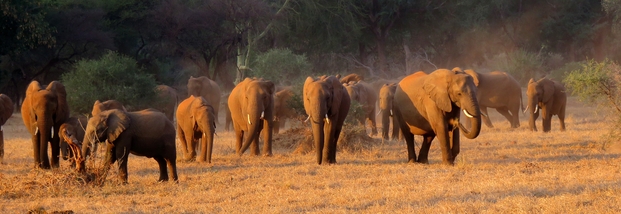
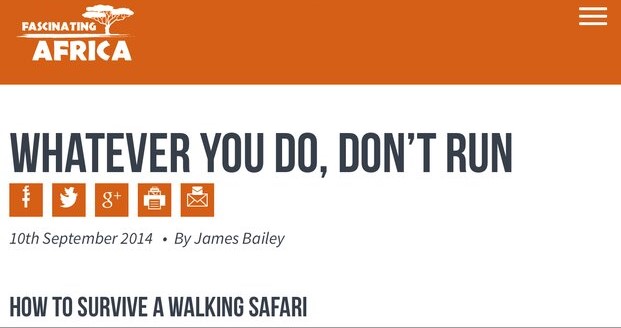
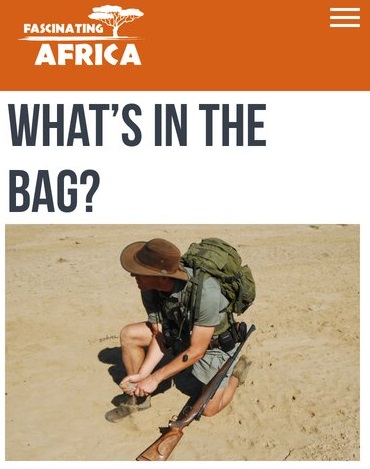
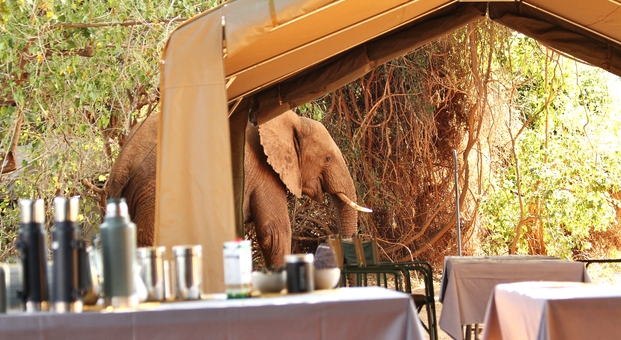

 Previous Post
Previous Post
